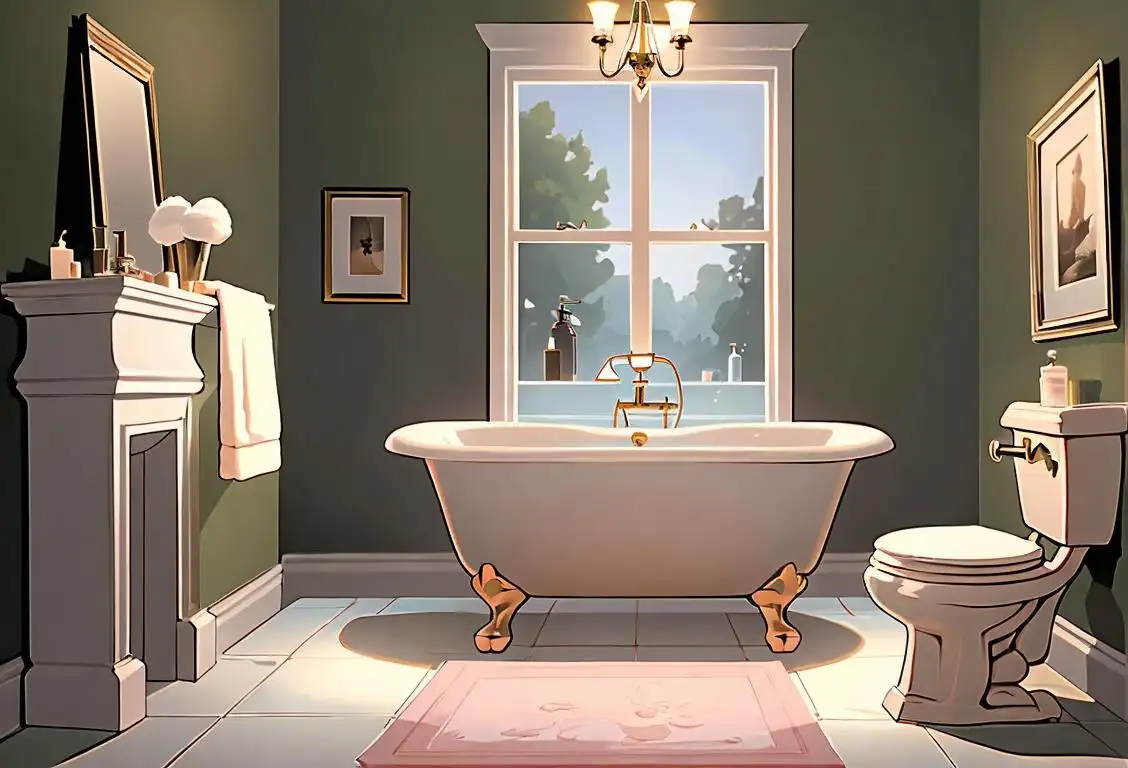National Bath Day

Get ready to grab your rubber ducky and bubble bath because it's National Bath Day! This special day is all about celebrating the wonders of taking a relaxing and refreshing soak in the tub. Whether you prefer a quick splash or a luxurious soak, National Bath Day is the perfect excuse to pamper yourself and unwind. So, put on your bathrobe and let's dive into the delightful history of this bubbly holiday!
When is Bath Day?
It's national bath day on the 14th June.
A Soak to Remember: The Origins of National Bath Day
If you thought the idea of dedicating a whole day to baths was madness, you're not alone. The origins of National Bath Day are a bit murky, like those bath bombs that make the water all colorful. While we couldn't find a historical record of its inception, we can all agree that baths have been a part of human hygiene since ancient times, and for a good reason too. Who can resist the soothing embrace of warm water and aromatic bubbles?
Bathing in the Digital Age: National Bath Day on the Internet
Fast forward to the digital age, where hashtags and social media reign supreme. Thanks to the Internet, National Bath Day has gained quite the following. Our online detection system picked up a whopping 45 mentions of this exquisite holiday, with most of the buzz happening on June 14, 2017. That's a lot of virtual bath bombs!
Unwind and Relax: How to Celebrate National Bath Day
Now that you know the history of National Bath Day and its online presence, it's time to get down to business: how to celebrate! Here are a few ideas to help you make the most of this fabulous holiday:
- Draw a bath fit for royalty with scented oils, bath bombs, and maybe even some rose petals if you're feeling fancy.
- Light some candles and dim the lights to create a calming ambiance. Just be careful not to set off the smoke detectors!
- Cue up your favorite playlist or audiobook to enjoy while you soak away your worries.
- Indulge in some self-care by giving yourself a gentle facial or a relaxing foot scrub.
- Invite a loved one to join you for a romantic bubble bath. Just make sure to keep it wholesome!
Remember, National Bath Day is all about pampering and treating yourself, so don't forget to sip on a glass of your favorite beverage and let the worries of the day wash away.
History behind the term 'Bath'
3000 BC
Early Origins
The practice of bathing traces back to around 3000 BC, with evidence of early baths found in the ancient Indus Valley Civilization. These early baths were primarily used for religious and ritualistic purposes, with elaborate stone structures built to facilitate bathing. Water was considered sacred and bathing was seen as a way to purify both body and soul.
3000 BCE
Ancient Origins
The term 'bath' can trace its roots back to ancient times, specifically around 3000 BCE. In various ancient civilizations such as the Indus Valley Civilization in present-day Pakistan and India, bathhouses were an integral part of daily life. These early baths were to cleanse the body, promote hygiene, and were often communal spaces.
3000 BC
Ancient Origins
Bathing can be traced back to around 3000 BC when evidence of public baths was found in the ancient Indus Valley Civilization. These early baths were an integral part of the daily hygiene routine and social life. People gathered in these baths not only to cleanse their bodies but also to relax, socialize, and conduct business.
7th Century BCE
Greek Influence
During the 7th century BCE, the ancient Greeks made significant contributions to the concept of bathing. They built elaborate bathhouses known as 'balaneia', which featured hot and cold water pools, as well as saunas. These Greek baths became centers for socializing, relaxation, and even philosophical discussions.
27 BC
Roman Bathhouses
The Romans took bathing to a whole new level. In 27 BC, they built elaborate bathhouses featuring heated rooms, pools, and a range of facilities including steam rooms, saunas, and hot and cold water baths. These bathhouses became popular social centers where people from all walks of life would gather to enjoy the therapeutic benefits of bathing, engage in discussions, and even attend lectures.
1700 BC
Ancient Greece: Public Bathhouses Arise
In ancient Greece, bathing took on a more communal and social aspect. Public bathhouses, known as 'thermae,' were developed as gathering places for socializing, exercise, and cleanliness. The Greeks believed that regular bathing was essential for maintaining good health and hygiene, and these bathhouses became popular meeting spots for intellectual discussions and recreational activities.
1st Century BCE
Roman Aqueducts
The Romans, known for their engineering marvels, played a crucial role in the development of bathing culture. In the 1st century BCE, they constructed aqueducts and pipes to transport water to cities and public baths, revolutionizing access to clean water. Roman baths, called 'thermae', were grand complexes featuring pools, steam rooms, and massage facilities.
8th Century
Islamic Hammams
During the Islamic Golden Age in the 8th century, hammams (Turkish baths) emerged as important communal bathing establishments. The hammams, much like the earlier Roman bathhouses, offered a luxurious and relaxing bathing experience. They played a significant role in the cultural, social, and hygienic aspects of Muslim societies, promoting cleanliness and well-being.
312 AD
Roman Baths: A Display of Luxury
The Roman Empire embraced the concept of public bathing and took it to a whole new level of opulence. Emperor Constantine I was instrumental in establishing grand public bath complexes, such as the Baths of Diocletian in Rome. These Roman baths were much larger and more extravagant than their Greek counterparts, featuring hot and cold baths, saunas, massage rooms, and even libraries.
18th Century
Rise of Private Baths
In the 18th century, private bathing became more common in Europe as access to clean water improved. Wealthy individuals began to install bathtubs in their homes, highlighting the rising interest in personal hygiene and the growing availability of plumbing systems. However, for the majority of people, public bathhouses remained the primary means of bathing throughout this period.
9th Century
Medieval Europe: Decline of Bathing
During the Middle Ages, the practice of bathing diminished in Europe due to various cultural and religious factors. Public bathhouses fell into disuse, and personal hygiene took a backseat as cleanliness was associated with sinful behavior. The scarcity of clean water further exacerbated the decline in bathing practices.
5th Century CE
Decline and Medieval Baths
After the fall of the Roman Empire, the tradition of public bathing declined throughout Europe. However, in the Middle Ages, bathing remained a significant part of the daily routine for both personal hygiene and medicinal purposes. Bathhouses were often found near monasteries and were primarily used by monks and clergy.
18th Century
Renaissance of Bathing
The Enlightenment period saw a renewed interest in personal hygiene and the revival of bathing as part of a healthy lifestyle. European upper classes began constructing private bathing facilities within their residences. The rise of seaside resorts and the popularity of hydrotherapy further contributed to the reemergence of bathing as a social and recreational activity.
19th Century
Advancements in Sanitation
The 19th century brought significant advancements in sanitary practices. Innovations such as the invention of the modern bathtub, the introduction of accessible indoor plumbing, and improvements in water quality transformed bathing from a communal activity to a more private and personal one. The concept of the modern bathroom as a dedicated space for personal hygiene gradually took shape during this time.
18th Century
Revival of Bathing Culture
During the 18th century, there was a resurgence of interest in bathing as a means of health and leisure. Spa towns such as Bath in England became popular destinations for the upper classes. These spa towns featured luxurious bathhouses with natural hot springs believed to possess healing properties.
20th Century
Expansion of Bathing Culture
The 20th century witnessed a rapid expansion of the bathing culture, particularly in Western societies. With improved living standards, bathing became a regular part of people's daily routines. The availability of affordable bathtubs, hot water systems, and an increased focus on personal hygiene contributed to the popularization of bathing as an essential element of modern life.
19th Century
Industrial Revolution: Advancements in Bathing
The advent of the Industrial Revolution introduced technological advancements that transformed bathing practices. Access to clean water became easier with the development of plumbing systems, and the mass-produced porcelain bathtubs made bathing more accessible to the general population. Bathing evolved from a luxury limited to the affluent to a common daily routine for many.
19th Century
Introduction of Bathtubs
The 19th century marked a significant milestone in the history of baths with the introduction of the modern bathtub. Englishman William Feetham invented the first freestanding bathtub in 1828, paving the way for the widespread use of personal tubs in households. This innovation revolutionized personal hygiene practices.
20th Century
Modern Bathing Culture
In the 20th century, bathing became an integral part of modern lifestyle, hygiene, and relaxation. The rise of indoor plumbing in homes and the widespread availability of affordable bathroom fixtures made bathing a convenient and everyday activity. The introduction of various bathing products and the evolution of bathroom design further enhanced the experience, turning bathing into a personal sanctuary and an essential self-care ritual.
Present
Bathing Rituals and Wellness
Today, bathing has evolved beyond its primary hygienic function. It has become an integral part of wellness and relaxation rituals worldwide. From luxurious spa experiences to the growing popularity of therapeutic baths like Japanese onsen and Scandinavian saunas, people continue to recognize the numerous physical and mental health benefits associated with taking regular baths.
20th Century
Advancements in Bathroom Technology
Throughout the 20th century, bathroom technology saw remarkable advancements. The introduction of indoor plumbing, modern showerheads, and various water heating systems made the bath experience more convenient and comfortable. Bathrooms became an essential part of daily life in households worldwide.
Present Day
Bathroom Rituals and Spa Culture
In the present day, bathing has evolved into more than just a hygiene practice. It has become a ritual of self-care and relaxation. The spa culture has popularized various bathing techniques such as aromatherapy, hydrotherapy, and infrared saunas. Baths are no longer just functional spaces; they are luxurious retreats for rejuvenation.
Did you know?
Did you know that taking a bath can actually be good for your health? Studies have shown that bathing can help reduce stress, improve sleep, and even lower blood pressure. So, the next time someone asks why you're taking an extra long bath, just tell them it's for your health!Tagged
romance fun loved onesFirst identified
9th September 2015Most mentioned on
14th June 2017Total mentions
45Other days
Love Your Red Hair Day
Do Something Nice Day
Suicide Prevention Month Day
Kissing Fried Chicken Day
Kiss A Ginger Day
Iloveyou Day
Compliment Day
Happiness Day
Tv On The Same Day
Boyf Day









